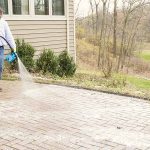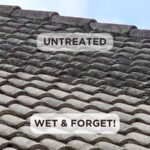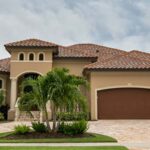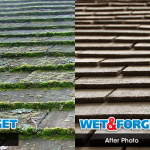Decking Cleaning Tips & Tricks
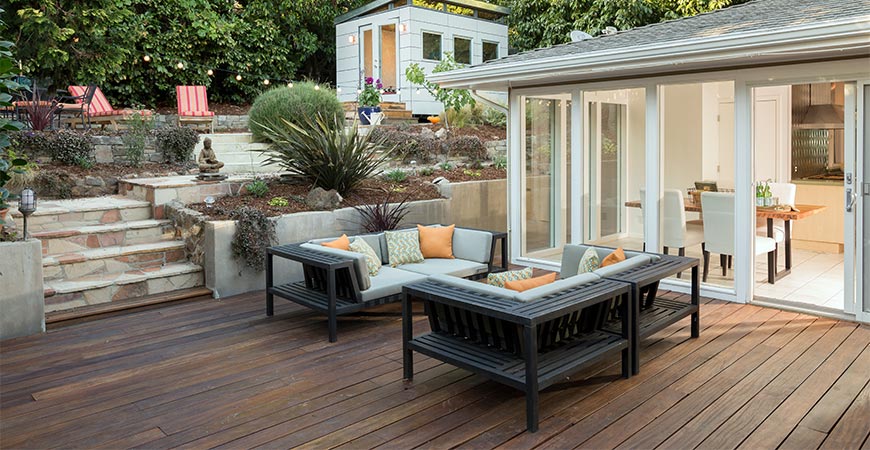
As the warm weather starts to roll in, the season for hosting outdoor barbeques, family parties, and al fresco dining is almost among us. Don’t let a dirty or stained deck spoil your next party!
Here we’ll cover the most popular types of deck material, and how to easily clean decking with Wet & Forget Outdoor.
What are the most commonly used decking materials?
The following four types of decking material are most popular for residential homes
Composites
The composite deck material is sold under several brand names including Trex®, TimberTech®, Cali Bamboo®, and MoistureShield®. Composite material is made of a blend of wood fiber and recycled plastic.
This creates a tough deck material that is weather-resistant and stain-resistant. Although, not 100% natural, composite decks will not warp, rot, or split.
Composite decking has an advantage over wood because it is low-maintenance; no staining, refinishing, or sanding is required. But composites aren’t entirely maintenance-free.
Mold and mildew can develop in damp, shady locations, and due to its wood fiber content, will eventually show signs of decay.
Pressure-treated lumber
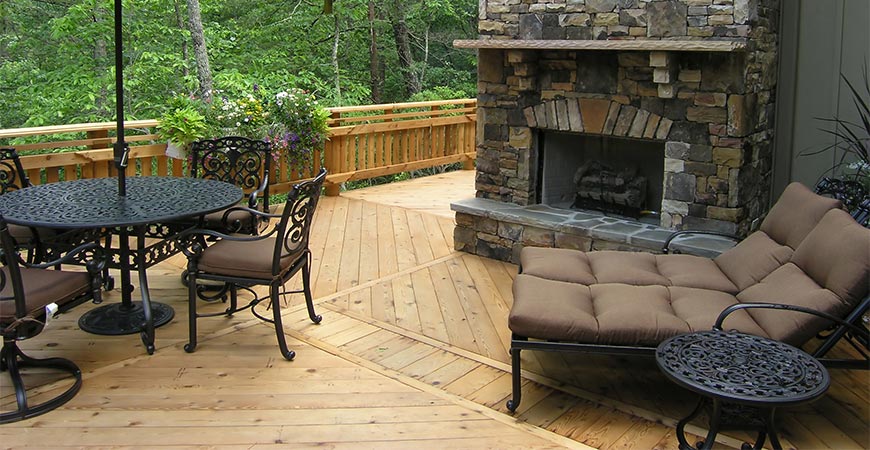
Pressure-treated lumber is the most popular decking material sold today. According to a leading producer of wood preservatives, roughly 75% of all new decks are made with pressure-treated lumber.
And it is a popular choice for a good reason. Pressure-treated lumber is affordable and widely available.
This type of material is easy to cut and assemble. The majority of wood product is southern yellow pine, which is chemically treated to withstand wood-boring bugs, rot, and fungus.
A deck made of pressure-treated lumber require routine maintenance in order to preserve the life and look of the wood. A yearly cleaning and an application of stain or wood preservative are recommended every two to three years.
Natural woods: Red Cedar and Redwood
For the environmentally-conscious, natural redwood or red cedar decking is a popular choice. Well known for their beautiful color and organic beauty, both wood species contain natural oils and tannins.
This makes these western softwoods naturally resistant to insects, rot, and decay. In most states, redwood and cedar cost about three times more than pressure-treated lumber.
Redwood and red cedar require a yearly cleaning and a coat of wood preservative every three to four years.
Exotic Hardwoods
Natural tropical woods used for decking come with interesting names like cumaru, red tauari, tigerwood, and massaranduba. These hard, durable deck materials are richly-grained and naturally resistant to wood-boring insects and rot.
Deck material made of tropical hardwood is expensive when compared to pressure-treated lumber, but in most parts of the U.S., the price is comparable to red cedar or redwood.
If you wish to leave your tropical wood deck unstained, apply a UV-blocking wood preservative every three to four years.
If you plan to buy wood decking material, check with the seller to make sure the wood was harvested in a sustainable manner. Information on wood sustainability is available from the nonprofit organization, the Forest Stewardship Council.
What’s wrong with using bleach on my deck?
Although chlorine bleach is great for cleaning and sanitizing hard nonporous surfaces, applying bleach to a wood deck has several disadvantages:
Bleach can break down the natural polymers that hold wood together, causing surface damage to healthy wood.
If you enjoy the look of your deck, you may not want to use bleach. Bleach can potentially lighten the color of stained, painted, or natural wood decks.
Bleach literally ‘bleaches’ the wood and growth. You may not notice it at first, but over time, your deck will appear lighter in color.
Your deck can appear to be clean from the green and black growth because it is bleached out. However, the growth is still remaining on the surface and can regrow on your deck very quickly.
Bleach can alter the natural pH of wood; damaging its cellular structure. Wood is slightly acidic (near neutral pH) while bleach has a basic pH. So bleach applied to wood can break down wood fibers and prematurely age your deck.
Cleaning with bleach can see simple, but there are many precautions that have to be taken when using bleach. Many bleach-based cleaners require rinsing before the surface has dried.
This can be difficult to accomplish, as the drying time period can vary from surface to surface and can change depending on the temperature as well.
Although cleaning with bleach does kill mold and mildew, it does nothing to eliminate mold spores, which is how mold and mildew stains start.
Bleach can corrode your deck’s metal fasteners, screws, nails- any metal part used to hold your deck together.
How do I apply Wet & Forget Xtreme Reach™ Hose End to my deck?
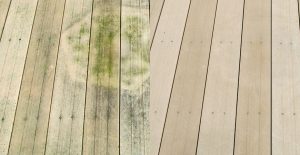
Wet & Forget Xtreme Reach™ Hose End eliminates ugly stains from moss, lichen, green algae, black algae, mold, and mildew on your deck, and takes the guesswork out of cleaning. It also keeps growth away for up to a year or more!
Wet & Forget is a gentle bleach-free cleaner that works with the rain and wind to clean up your deck. Green algae is a particular problem on decks.
If tracked inside, it can stain indoor flooring, carpeting, and rugs. Plus, green algae can make your deck slippery to walk on creating a fall hazard.
How to clean decking with Wet & Forget Xtreme Reach™ Hose End
- Attach the container to your garden hose
- Attach the Fan tip to the sprayer
- Turn the black dial on the sprayer to the “ON” setting
- Spray the affected area with the product allowing for a minimum of 4 to 5 hours’ drying time.
- You’re Done!
Wet & Forget Outdoor’s easy spray-on-and-leave formula works with Mother Nature to wipe out ugly deck stains. It cleans the deck for you – no scrubbing or pressure washing required!
Retreat your deck once a year, or at the first sign of re-growth.
Just spray on and leave – let Wet & Forget do the work for you!

A note about lichen:
The Wet & Forget Outdoor product instructions for lichen differs due to its multi-layered and complex structure. To eliminate lichen:
- Spray the lichen with the solution, being sure to fully saturate the growth.
- Wait 15 minutes and then spray the surface again, completely saturating the surface.
- This double application allows Wet & Forget Outdoor to thoroughly penetrate lichen, banishing it from your deck.
Hints for cleaning success:
- Check the weather forecast before you spray as the product needs a span of 4 to 5 hours to dry on the surface, before the chance of rain.
- Applying Wet & Forget Outdoor on a hot day may cause the product to dry too quickly. It’s best to apply Wet & Forget Outdoor on a cloudy day, or in the early morning. This will give the product time to penetrate and begin eliminating ugly growth.
- If your deck feels hot to touch, don’t apply Wet & Forget. Wait for a cooler day, so the product can sit on the surface and fully attack the growth.
How soon can I paint or stain my deck after using Wet & Forget Outdoor Cleaner?
You’re free to stain, seal, or paint your deck immediately after stains and growths have disappeared.
To find Wet & Forget products at a store near you or online, click here. You can also send us a message here or give us a call Monday through Friday, 8:30am-5pm CT: 888-727-8524.


